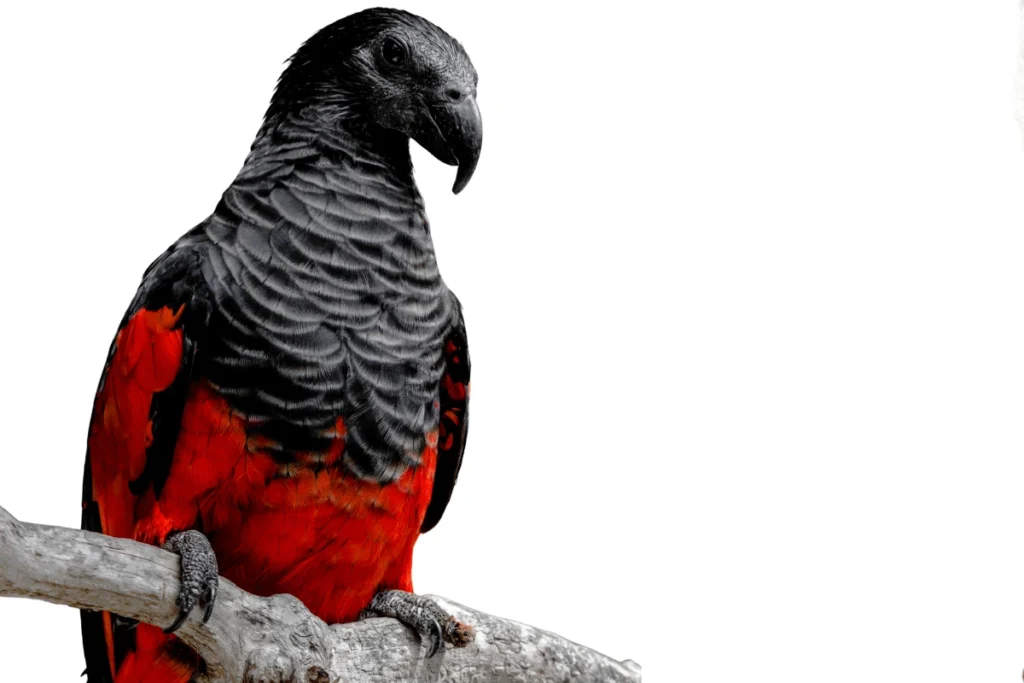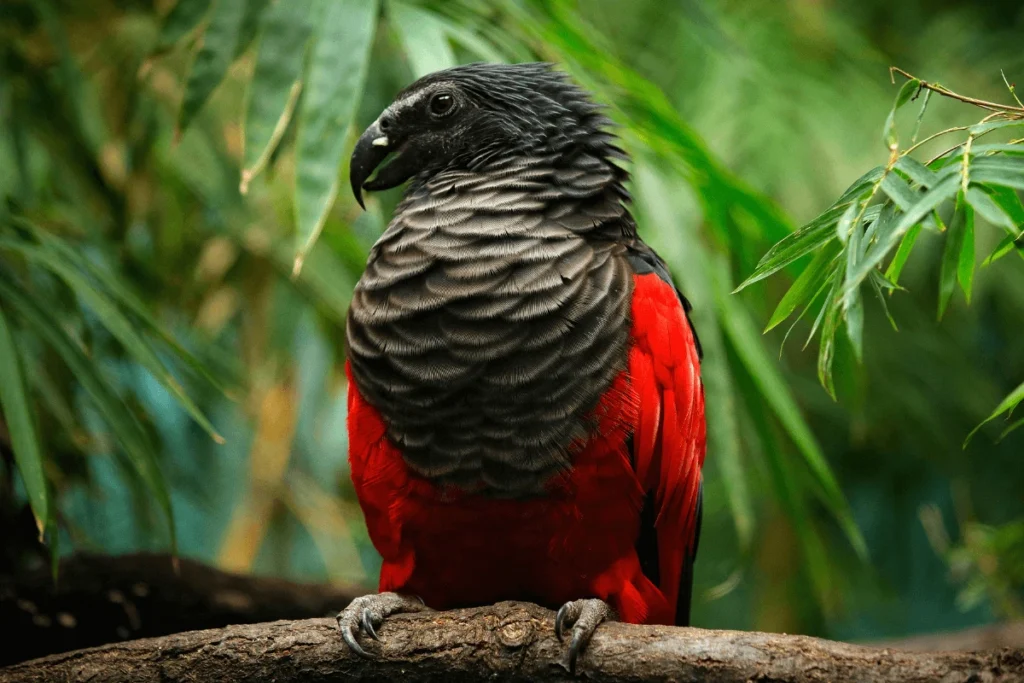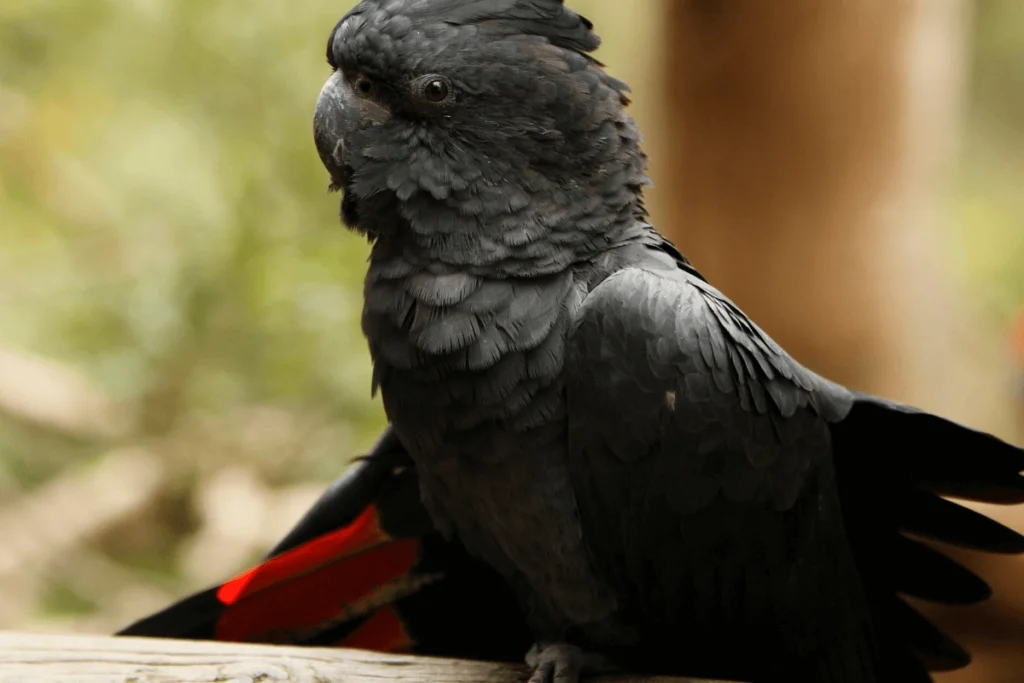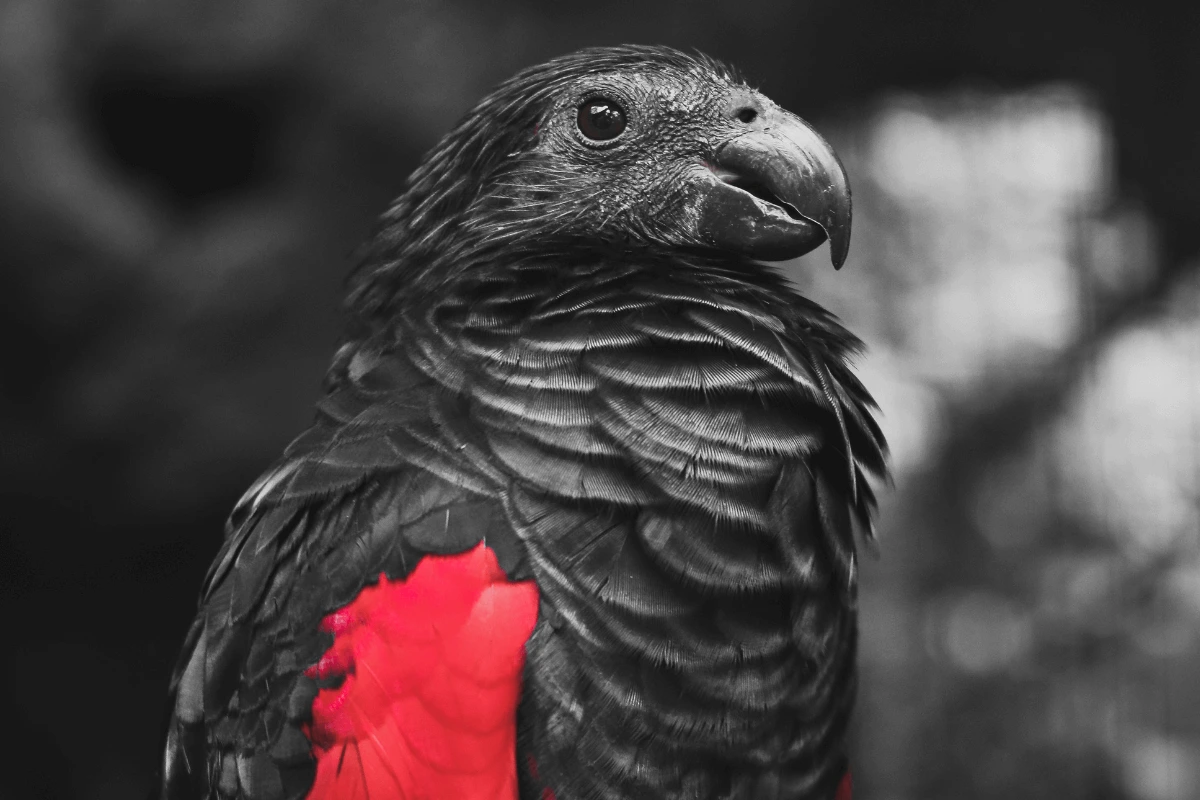The Dracula Parrot lifespan is one of the most fascinating aspects of this rare and exotic bird. Also known as Pesquet’s Parrot (Psittrichas fulgidus), this striking species stands out with its jet-black feathers, bright red underwings, and vulture-like appearance. Unlike most parrots, it has a unique diet, habitat, and behaviors that influence how long it lives. Many bird enthusiasts and researchers consider it one of the most extraordinary parrots in the world.
This blog post will reveal 10 astonishing truths about the Dracula Parrot’s lifespan, including factors that affect its longevity, its survival challenges, and why conservation efforts are crucial. You’ll also discover fascinating details about its diet, habitat, and rare characteristics that make it unlike any other tropical rainforest bird. Let’s dive into the incredible world of this mysterious parrot and uncover the secrets behind its lifespan.
What Is the Dracula Parrot? A Unique and Rare Species
Pesquet’s Parrot: The Real Name of the Dracula Parrot
Many people recognize this bird as the Dracula Parrot, but its real name is Pesquet’s Parrot (Psittrichas fulgidus). Scientists named it after Alfred Pesquet, a French naturalist who studied rare birds. Unlike other parrots, it belongs to a unique taxonomic group with no close relatives.
The Dracula Parrot stands out not just for its appearance but also for its habits. While most parrots use their strong beaks to crack nuts and seeds, Pesquet’s Parrot primarily feeds on soft fruits. This diet, along with its limited range, plays a major role in the Dracula Parrot lifespan and overall survival. Understanding its true identity helps highlight how rare and special this species truly is.
Where Do Dracula Parrots Live? Their Natural Habitat in Papua New Guinea
The Dracula Parrot lives exclusively in the lush, mountainous rainforests of Papua New Guinea. This bird prefers the rainforest canopy, where it finds food and shelter high above the forest floor. The dense vegetation and towering trees provide an ideal environment for these tropical rainforest birds to thrive.
Unlike some parrots that adapt to different environments, Pesquet’s Parrot depends entirely on undisturbed rainforests. It prefers elevations between 600 and 1,800 meters, where fig trees and other fruit-bearing plants are abundant. Unfortunately, deforestation and habitat destruction threaten its survival. As more rainforests disappear, the Dracula Parrot lifespan may decline due to food shortages and increased human activity.
Papua New Guinea remains one of the last strongholds for this species, but conservation efforts are necessary to protect its habitat. Without these forests, the world could lose one of its most unique bird species.
Why Is It Called the Dracula Parrot? Unveiling Its Mysterious Look
The name Dracula Parrot perfectly matches this bird’s eerie, almost gothic appearance. Unlike the bright green and colorful plumage of most parrots, Pesquet’s Parrot has black feathers, dark gray facial skin, and piercing red eyes that give it a haunting look. The contrast of its scarlet red chest and wings against its dark body makes it one of the most striking exotic bird breeds in the world.
Its vulture-like head adds to its Dracula-inspired reputation. Unlike other parrots, it has a bare, featherless face, which helps keep sticky fruit pulp from clinging to its skin while eating. This feature makes it resemble a vulture more than a typical parrot. However, despite its intimidating look, the Dracula Parrot is harmless and plays a crucial role in its ecosystem by spreading seeds from the fruits it eats.
Because of its rare and mysterious appearance, wildlife enthusiasts and birdwatchers often consider it one of the most unique parrot species on the planet. However, its beauty has also made it a target for poachers, further endangering its population. The more people learn about this incredible bird, the better the chances of protecting its future and ensuring a long Dracula Parrot lifespan.
How Long Do Dracula Parrots Live? Understanding Their Lifespan
Pesquet’s Parrot Lifespan in the Wild vs. Captivity
The Dracula Parrot lifespan varies depending on its environment. In the wild, Pesquet’s Parrot typically lives between 15 and 20 years, but in captivity, its lifespan can be shorter due to stress and improper care. Unlike other parrots that thrive in aviaries, the Dracula Parrot has specialized needs that make it difficult to keep in captivity.

In the wild, these birds have access to a natural diet of tropical fruits, a vast flying space, and the complex social interactions they need for a healthy life. However, they also face dangers such as habitat destruction, poaching, and natural predators, which can shorten their lifespan.
Captivity does not always guarantee a longer life for Pesquet’s Parrot. Many attempts to breed them in zoos or aviaries have failed because they do not adapt well to enclosed spaces. Their diet, which consists almost entirely of soft fruits, also makes them prone to nutritional deficiencies when they do not receive the right food. Additionally, their need for large, unrestricted flight areas makes them unsuited for small enclosures.
While some parrot species live much longer in captivity, the Dracula Parrot lifespan often remains the same—or even shorter—when removed from its natural habitat. Conservation efforts focus on protecting them in the wild rather than breeding them in captivity.
Factors That Influence Their Longevity
Several factors determine the Dracula Parrot lifespan, including diet, habitat conditions, and threats from humans.
- Diet and Nutrition
Unlike other parrots that eat seeds and nuts, the Dracula Parrot relies mainly on figs and other soft fruits found in the rainforest canopy. This diet keeps them healthy in the wild, but a lack of proper nutrition in captivity can lead to health problems that shorten their lifespan. - Habitat and Environmental Conditions
The Dracula Parrot thrives in the tropical rainforests of Papua New Guinea, where it has enough food and space to fly. However, deforestation has significantly reduced its habitat, making it harder for these birds to survive. A shrinking environment means less food, more competition, and a higher risk of predation. - Threats from Poaching and the Illegal Pet Trade
Many exotic bird collectors seek the Dracula Parrot for its striking appearance, but this demand has led to illegal hunting and trade. Trapping these birds and removing them from their natural environment causes extreme stress, which often results in a shorter lifespan. - Predators and Natural Dangers
Although adult Pesquet’s Parrots do not have many natural predators, birds of prey and large snakes occasionally target their eggs and young. Climate change and extreme weather conditions also pose threats to their survival by disrupting their food supply.
By understanding these factors, conservationists can take better steps to protect this rare and unique bird species and improve its chances of survival.
Comparing Their Lifespan to Other Rare Parrot Species
Compared to other parrots, the Dracula Parrot lifespan is relatively short. Some parrot species live over 50 years, while Pesquet’s Parrot typically survives 15 to 20 years in the wild.
- Macaws (50–70 years)
Large macaws, such as the Hyacinth Macaw and Scarlet Macaw, can live for several decades, especially in captivity. Their long lifespan is partly due to their ability to adapt to human care and a more diverse diet. - African Grey Parrots (40–60 years)
These parrots are known for their intelligence and long lifespan. In captivity, they often live longer than in the wild because of controlled diets and medical care. - Kea Parrot (20–30 years)
The Kea, a parrot native to New Zealand, shares some similarities with the Dracula Parrot in terms of habitat challenges and diet. However, Keas tend to live longer due to fewer threats from poaching.
The Dracula Parrot lifespan is shorter mainly because of its specialized diet, habitat loss, and low adaptability to captivity. Unlike other parrots, it does not thrive in human care, making conservation in the wild even more critical for its survival. Protecting the rainforests of Papua New Guinea is the best way to ensure that this extraordinary species continues to exist for future generations.
The Dracula Parrot’s Diet: A Key to Its Survival
What Do Dracula Parrots Eat? Their Special Fruit-Based Diet
The Dracula Parrot has one of the most specialized diets among parrots. While many parrots eat a variety of seeds, nuts, and fruits, Pesquet’s Parrot feeds almost exclusively on soft fruits, especially figs. This makes it one of the few fruit-eating parrots that depend on a very limited selection of food sources.
Its diet consists mainly of figs from rainforest trees, particularly species from the Ficus genus, which provide essential nutrients. Occasionally, it may eat other fruits, but unlike other parrots, it does not consume nuts, seeds, or insects. Its beak is specially adapted for this diet—it is curved and sharp, allowing the bird to efficiently extract fruit flesh while leaving behind tough skins and seeds.
Because of its reliance on fruit, the Dracula Parrot plays a vital role in its ecosystem. As it moves from tree to tree in search of food, it spreads seeds, helping new plants grow and maintaining the balance of the tropical rainforest. Without this unique parrot species, the rainforest’s plant diversity could decline.
How Their Diet Affects Their Health and Lifespan
The Dracula Parrot lifespan heavily depends on its diet. Since it primarily consumes figs and other soft fruits, it gets all its nutrients from a limited food source. This diet keeps them healthy in the wild, but it also makes them vulnerable to changes in their environment.
- Nutritional Balance
The fruits Pesquet’s Parrot eats provide natural sugars, fiber, and essential vitamins, keeping it active and healthy. However, the lack of protein and fat, which other parrots get from nuts and seeds, means this species relies entirely on the quality and availability of its food. - Effects of Habitat Loss
As deforestation reduces the number of fig trees in Papua New Guinea’s rainforests, the Dracula Parrot faces food shortages. This directly affects its health, making it harder to find enough food to sustain a healthy lifespan. - Challenges in Captivity
The bird’s unique diet makes it extremely difficult to care for in captivity. Many fruit varieties available in aviaries lack the exact nutritional composition of wild rainforest figs. When kept in zoos or by private owners, these parrots often suffer from malnutrition, which shortens their lifespan. This is one reason why conservationists focus on protecting their natural habitat rather than breeding them in captivity.
Because of these dietary restrictions, the Dracula Parrot lifespan is closely tied to the health of the rainforest. If the forests continue to shrink, these parrots may struggle to survive, making conservation efforts more important than ever.
Why They Rely on Rainforest Canopy Fruits
The Dracula Parrot spends most of its time in the rainforest canopy, where it finds the fruits it needs to survive. The canopy, or the upper layer of the forest, is home to a variety of fruit-bearing trees that provide a consistent food supply.
- Adaptation to a Specialized Diet
Unlike other parrots that forage on the ground or eat a mix of foods, Pesquet’s Parrot has evolved to depend entirely on canopy fruits. Its sharp, curved beak allows it to extract fruit pulp efficiently, while its featherless face prevents sticky fruit residue from building up—similar to vultures that eat carrion. - A Life Above the Forest Floor
Staying in the canopy helps the Dracula Parrot avoid many ground-level predators. It moves between the treetops in small groups, searching for fruit-bearing trees. These feeding patterns make it an important part of the rainforest ecosystem, as it helps disperse seeds that grow into new trees. - The Risk of Habitat Destruction
Since these parrots rely entirely on rainforest canopy fruits, they suffer when deforestation removes their primary food sources. Logging, agriculture, and human expansion threaten their habitat, making it harder for them to find enough food. Without these fruit trees, the Dracula Parrot lifespan could decline drastically due to starvation and increased competition for resources.
Because the Dracula Parrot is so dependent on tropical rainforest fruits, protecting its natural habitat is crucial. Unlike some birds that can adapt to new diets, Pesquet’s Parrot cannot simply switch to eating seeds or insects. This makes rainforest conservation essential for the survival of this rare and exotic species.
Threats to the Dracula Parrot: Conservation and Endangered Status
Why Is the Dracula Parrot Endangered? Key Threats to Its Survival
The Dracula Parrot faces a serious decline in population, making it one of the most vulnerable rare parrot species in the world. The International Union for Conservation of Nature (IUCN) lists it as “Vulnerable”, meaning its numbers are decreasing at an alarming rate. Several factors contribute to its endangered status, but the two biggest threats are habitat destruction and poaching.

Unlike some adaptable birds, Pesquet’s Parrot depends entirely on the rainforests of Papua New Guinea for food and shelter. As these forests disappear, the parrot struggles to survive. At the same time, illegal hunters and traders target this species because of its striking black and red feathers, which are used in cultural ceremonies and sold in the exotic pet trade.
Another challenge is the Dracula Parrot lifespan itself. This species has a low reproductive rate, meaning it does not produce many offspring. Even if conservationists protect the remaining population, the slow breeding cycle makes recovery difficult. Without urgent action, the Dracula Parrot could move from “Vulnerable” to “Endangered” within a few decades.
Conservation Efforts to Protect This Rare Parrot Species
Conservationists and wildlife organizations are working to prevent the Dracula Parrot from becoming extinct. Since this species does not adapt well to captivity, most efforts focus on protecting its natural habitat and preventing illegal hunting.
- Rainforest Protection
Organizations are working to preserve the tropical rainforests of Papua New Guinea, where these parrots live. This includes creating protected areas where logging and deforestation are restricted. Keeping the rainforest canopy intact ensures that the Dracula Parrot has enough food and shelter to survive. - Anti-Poaching Laws and Enforcement
The illegal capture and trade of Pesquet’s Parrot remain serious issues. Authorities have implemented stricter laws to prevent wildlife trafficking, but enforcement is still a challenge. Conservation groups are working with local communities to raise awareness about the importance of protecting this rare parrot species. - Community Involvement and Sustainable Alternatives
In some areas, indigenous communities hunt Dracula Parrots for their feathers, which are used in traditional ceremonies. Conservationists are promoting sustainable alternatives, such as using artificial feathers, to reduce hunting pressure on the parrot population. Educating local communities about the ecological importance of these birds also helps shift attitudes toward conservation.
Despite these efforts, the Dracula Parrot lifespan and overall survival remain uncertain. Without continued support for conservation initiatives, the population may continue to decline. Protecting this unique species requires a global effort to address deforestation, illegal trade, and habitat destruction.
How Deforestation and Hunting Impact Their Population
Deforestation and hunting are the biggest threats to the Dracula Parrot lifespan and long-term survival. As human activities expand, these parrots lose the very resources they depend on.
- Loss of Rainforest Habitat
The Dracula Parrot relies entirely on the rainforest canopy to find food. However, logging and land development for agriculture have destroyed vast areas of Papua New Guinea’s forests. Without enough fruit-bearing trees, these parrots struggle to find food, leading to malnutrition and lower reproductive rates. - Impact of the Exotic Pet Trade
Although Pesquet’s Parrot does not adapt well to captivity, smugglers continue to capture them for the illegal pet trade. The stress of captivity often shortens their lifespan, and many do not survive transportation. The demand for exotic bird breeds fuels illegal wildlife trafficking, further reducing wild populations. - Cultural Hunting and Feather Trade
Indigenous communities in Papua New Guinea have traditionally hunted the Dracula Parrot for its distinctive black and red feathers. These feathers are used in ceremonial headdresses and decorations. While this practice has existed for centuries, increased hunting due to demand from collectors has put additional pressure on the population.
As deforestation continues and hunting persists, the Dracula Parrot lifespan and survival remain at risk. Protecting these birds requires a combination of habitat conservation, stronger enforcement of anti-poaching laws, and sustainable alternatives for local communities. Without these efforts, one of the world’s most unique bird species could face extinction in the near future.
Fascinating Facts About the Dracula Parrot
Its Unusual Feathers Make It Different From Other Parrots
The Dracula Parrot stands out from other parrots because of its unique feather structure and coloration. While most parrots display a mix of bright greens, blues, and yellows, Pesquet’s Parrot has a bold black and red plumage that gives it a gothic, almost eerie appearance. This striking contrast is rarely seen in other parrot species, making it one of the most visually distinct exotic bird breeds in the world.
One of its most unusual features is its bare, featherless face, which is similar to that of vultures. Unlike parrots with fully feathered heads, the Dracula Parrot has dark gray, almost scaly skin around its face. Scientists believe this adaptation helps prevent sticky fruit pulp from clinging to its feathers while feeding. This trait is particularly important since Pesquet’s Parrot primarily eats soft fruits like figs, which can be messy.

Another difference is its soft and silky feather texture. Unlike other parrots, which have stiff and structured feathers, the Dracula Parrot’s feathers are looser, giving it a ruffled look. These adaptations not only set it apart visually but also play a role in its behavior and survival in the wild.
A Parrot That Doesn’t Mimic? The Unique Traits of This Bird
Most parrots are known for their ability to mimic human speech and sounds, but the Dracula Parrot breaks this rule. Unlike African Greys, Amazon Parrots, or Budgerigars, Pesquet’s Parrot does not have strong vocal mimicry skills. Instead, it communicates through a series of deep, raspy, and almost crow-like calls.
- Distinctive Vocalizations
The Dracula Parrot’s calls are often described as harsh, growling, and croaky, making them sound more like a raven than a parrot. These sounds help them communicate with their flock members and signal warnings about potential dangers in the rainforest. - Flight Behavior and Physical Adaptations
Unlike most parrots, which have strong beaks for cracking nuts and seeds, the Dracula Parrot has a more specialized, slender beak designed for feeding on soft fruits. This difference in diet means it does not need the powerful bite that other parrot species have. - Low Social Interaction
While many parrots are highly social and bond closely with humans in captivity, Pesquet’s Parrot is more independent. In the wild, they travel in small groups of 2 to 6 individuals, rather than forming large flocks. Their unique behavior and feeding habits make them one of the most unusual parrot species in the world.
Because of these differences, the Dracula Parrot lifespan and survival challenges are also quite different from those of other parrots. Their specialized traits make them harder to keep in captivity and more dependent on their natural habitat for survival.
Why the Dracula Parrot Is One of the Most Exotic Bird Breeds
The Dracula Parrot is often considered one of the most exotic bird breeds due to its rare appearance, unique behavior, and limited habitat range. Found only in the remote rainforests of Papua New Guinea, this bird remains a mystery to many birdwatchers and researchers alike.
- Rare and Hard to Find
Unlike macaws or cockatoos, which are widespread and often bred in captivity, the Dracula Parrot is rarely seen outside its natural habitat. Because of its specialized fruit diet, it does not adapt well to captivity, making it difficult for zoos and conservation programs to sustain. - A Living Gothic Symbol
With its black feathers, deep red chest, and eerie vulture-like face, the Dracula Parrot has an almost mythical presence. Its appearance has earned it comparisons to Dracula, adding to its mystery and appeal among bird enthusiasts. - A Critical Part of the Rainforest Ecosystem
Beyond its striking look, this parrot plays a vital role in seed dispersal. By feeding on rainforest fruits, it helps maintain plant diversity in its environment. Losing this species would not only be a loss to bird lovers but also to the fragile rainforest ecosystem that depends on it.
Because of its endangered status, striking appearance, and unusual behavior, the Dracula Parrot continues to captivate scientists, conservationists, and bird enthusiasts worldwide. However, without stronger conservation efforts, this rare species could become even harder to find in the wild, making it a true symbol of the disappearing biodiversity of tropical rainforests.
Conclusion
The Dracula Parrot lifespan and survival depend entirely on the health of Papua New Guinea’s tropical rainforests. As one of the most unique bird species, this rare parrot faces growing threats from deforestation, illegal hunting, and the exotic pet trade. Without urgent conservation efforts, the Pesquet’s Parrot could suffer severe population declines, making it even rarer in the wild.
Unlike other parrots, the Dracula Parrot has highly specialized needs. It relies on rainforest canopy fruits for food, which means habitat destruction directly impacts its ability to survive. Since this parrot does not adapt well to captivity, protecting its natural environment remains the best way to secure its future. Conservationists continue to work with local communities to raise awareness, enforce anti-poaching laws, and promote sustainable alternatives to hunting.
The Dracula Parrot stands out not only for its unusual appearance but also for its ecological importance. As a fruit-eating parrot, it helps disperse seeds and maintain the delicate balance of the rainforest ecosystem. Preserving this species means protecting the biodiversity of its home.
The future of the Dracula Parrot lifespan depends on collective action. Supporting conservation programs, promoting rainforest protection, and discouraging the illegal wildlife trade can help ensure that this rare and exotic bird continues to thrive in the wild. By valuing and protecting species like the Dracula Parrot, we take an important step toward preserving the natural world for generations to come.
Read More about the Dracula Parrot and Discover its Mysteries!
Read About Other Pets and breeds From HERE!
Find Out the Best stuff for your Pet On Pet MD Official.
